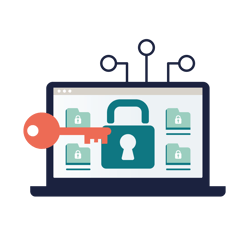How can IAM help ensure compliance?
Many companies today are challenged by keeping up with the increasing number of new requirements and directives. Identity and Access Management (IAM) and Identity Governance play a crucial role in ensuring that companies are aligned with the compliance requirements.
As digitalization continues to increase, companies today face an overwhelming number of new standards, rules, directives, and regulations they must adhere to. It's no longer sufficient for companies to merely recognize if they are subject to a new compliance rule; they must also consider how to implement it. While GDPR rules have become routine for many, the EU's stricter security directives, NIS2 and DORA, are now knocking at the door, and more are constantly being added.
Controll compliance challenges with identity management and Governance.
A cornerstone of digital compliance is robust identity management. Identity and Access Management (IAM) is about managing and controlling who has access to an organization's digital resources and for how long they retain this access. Identity Governance & Administration (IGA) is a subset of IAM and takes basic access and identity management a step further. IGA can help companies automate the workflows for managing identities and enforce processes and policies, making it easier to comply with current rules and regulations. It's essential to meet the compliance requirements set by various directives and regulations.
However, it can be a very complex task for companies to understand and comply with the different compliance requirements they face.
We've compiled a list of the typical challenges many encounter, and why Identity Management, in particular, can help companies address them.
What is Identity Governance?
Identity Governance is a branch within Identity and Access Management (IAM) that covers the security processes governing identities in an organization. As a crucial part of today's cybersecurity tech-stack, Identity Governance allows you to define, control, and monitor user rights to ensure they comply with compliance and minimize security risks.
→ Read more about the 7 reasons why your business needs Identity Governance.
Complex and changing rules and standards
One of the typical challenges businesses face is that compliance requirements are often very complex and can vary depending on the industry, geographical location, and the type of data the company manages. Moreover, the rules are not static; they change and are updated regularly to accommodate new technological advancements and security threats. Therefore, it can be challenging to keep pace with these changes.
Fortunately, an Identity Governance solution allows companies to tailor and automate their access control policies in line with current compliance requirements.
Automatic policy enforcement within the Identity Governance solution also ensures that policies are consistently and accurately adhered to.
Protection of sensitive data
Sensitive data is a particularly attractive target for cybercriminals. If a company does not have adequate access control and protection in place, they risk leaking or losing this data. IAM solutions enable companies to implement precise access controls, ensuring that only authorized users have access to sensitive data. A combination of an Access Management tool and an Identity Governance solution helps fulfill compliance requirements by logging and tracking all user activity. This provides evidence that sensitive data is being handled correctly and securely.
4 best practices to better equip for compliance
To better equip for compliance, here are four best practices to follow:
- Identify relevant compliance requirements: Understand which compliance requirements apply to your company and identify the specific requirements related to identity and access management.
- Conduct a risk assessment: Identify potential threats and risks concerning your digital assets.
- Implement an IAM solution: Choose an IAM solution capable of meeting the specific compliance requirements your company is subject to.
- Stay updated: Ensure that you keep up-to-date with changes in compliance requirements.

Avoid a lack of access control structure
Without a structured identity and access management process, businesses risk having inconsistent or insecure methods to protect user data.
This can lead to errors and misunderstandings and increase the risk that unauthorized users gain access to resources they shouldn't have. A lack of clear guidelines and control points also makes it challenging to meet compliance requirements for reporting.
With a combination of Access Management (AM), Privileged Access Management (PAM) and Identity Governance (IGA) a structured identity and access management structure is introduced with implemented roles and policies that define which users have access to which resources and to what extent. This makes it easier to manage access and ensures that policies are consistently enforced across the company. Moreover, it ensures that changes in user rights are detected and addressed quickly, which is essential for compliance requirements.
Schedule a meeting
If you're interested in discussing the possibilities of an IAM solution for your company, feel free to schedule a meeting with us.
→ Click here to book a meeting











